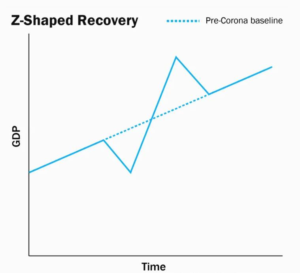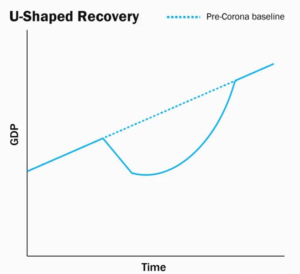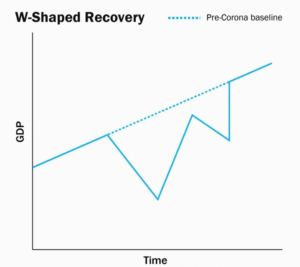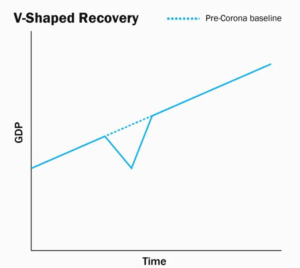In News: Recently, the industry chamber ASSOCHAM has said that India’s economy is showing decisive signs of a ‘V-shaped’ recovery in 2021.
Types of Shape of Economic Recovery
- Economic recovery can take many forms, which is depicted using alphabetic notations. For example, a Z-shaped recovery, V-shaped recovery, U-shaped recovery, elongated U-shaped recovery, W-shaped recovery and L-shaped recovery.
- The alphabets generally denote the graph of growth rate, which resembles the shape of the letter.
- The fundamental difference between the different kinds of recovery is the time taken for economic activity to normalize.
- The time taken is often a factor of multiple things such as the depth of the economic crisis. e.g deeper the recession, longer is the time to get back to normal.
- The other aspect of economic recovery includes the effect of pandemic on jobs and household incomes, and the kind of policy response taken by the government that determines how quickly economic growth will recover.
Z-shaped recovery
- It is the most-optimistic scenario in which the economy quickly rises after an economic crash.
- It makes up more than for lost ground before settling back to the normal trend-line, thus forming a Z-shaped chart.
- In this economic disruption lasts for a small period wherein more than people’s incomes, it is their ability to spend is restricted.

U-shaped recovery
- It is a scenario in which the economy, after falling, struggles around a low growth rate for some time, before rising gradually to usual levels.
- In this case several jobs are lost and people fall upon their savings.
- If this process is more-long drawn than it throws up the “elongated U” shape.

W-shaped recovery
- A W-shaped recovery is a dangerous creature.
- In this, growth falls and rises, but falls again before recovering, thus forming a W-like chart.
- The double-dip depicted by a W-shaped recovery can be due to the second wave of the pandemic.

L-shaped recovery
- In this, the economy fails to regain the level of GDP even after years go by.
- The shape shows that there is a permanent loss to the economy’s ability to produce

Special Focus on V-shaped recovery
- It is the next-best scenario after Z-shaped recovery in which the economy quickly recoups lost ground and gets back to the normal growth trend-line.
- In this, incomes and jobs are not permanently lost, and the economic growth recovers sharply and returns to the path it was following before the disruption.

What is a V-shaped Economic Recovery?
- V-shaped recovery is a type of economic recession and recovery that resembles a “V” shape in charting.
- V-shaped recovery represents the shape of a chart of economic measures economists create when examining recessions and recoveries.
- V-shaped recovery involves a sharp rise back to a previous peak after a sharp decline in these metrics.
- In a V-shaped recovery, after the economy suffers a sharp economic decline, it then quickly and strongly recovers.
- A “V-shaped” recovery suggests that economic spending and employment will rapidly decline, but quickly pick back up like a V.
Key Highlights
- The Indian economy witnessed the return of consumer confidence, robust financial markets, an uptick in manufacturing and exporters braving it out in the global market with never-say-die spirit.
- The high-frequency data is a strong pointer to a V-shaped recovery in 2021 with the seeds bursting into green shoots over the last two months of 2020.
- India’s GDP is estimated to contract by a record 7.7 per cent during 2020-21 as the COVID-19 pandemic severely hit the key manufacturing and services segments.
Challenges for India in V-shaped Economic Recovery
- Disconnect with Ground Reality: The indicators suggesting a V-shape recovery “cannot provide a perfect picture of the ongoing experiences of Indian households.
- Not so Rosy: Recognizing that the key indicators including GST collections and the unemployment rate don’t necessarily capture many important features of the economy on the ground for the average person.
- More Cash Transfers are needed: The rating agency Moody’s had recently revised its growth projections for India’s GDP in calendar 2020 from minus 9.6% to minus 8.9% which buttressed her claim that the Indian economy was rebounding.
















